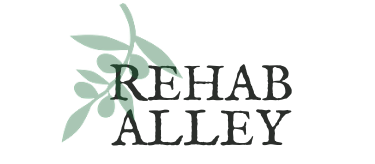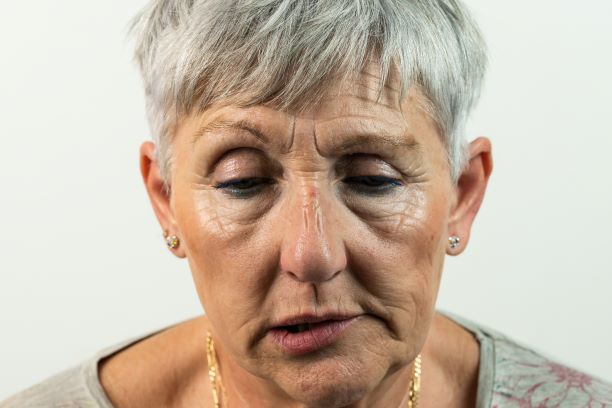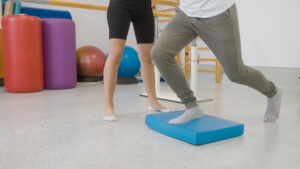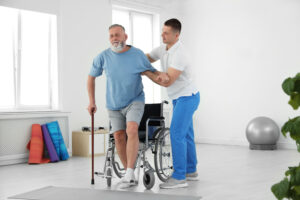Table of Contents
Every year over 795,000 Americans have a stroke, and every 4 minutes someone dies of a stroke. (Link) Strokes are also the leading cause of disability and the 5th leading cause of death for Americans. (Link) According to the CDC, stroke takes the life of 140,000 Americans each year and costs the United States approximately $34 billion each year.
Another troubling statistic found on the CDC website is that 87% of all strokes are ischemic strokes which are caused by clots that block blood flow to the brain. This indicates that most strokes are PREVENTABLE.
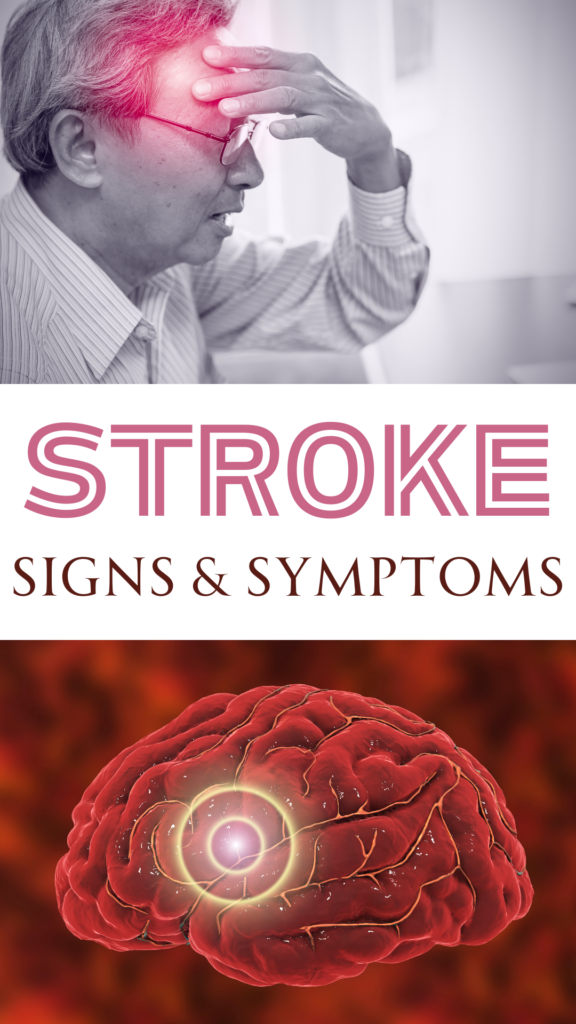
With the help of organizations such as the CDC and American Stroke Association, most people have been educated on the signs and symptoms of a stroke. However, I wanted to take this information a step further and discuss the characteristics of stroke as well as what to expect during rehabilitation.
Property of rehaballey.com
It is important for individuals to get as much information as possible to reduce the occurrences of stroke in the future. It is also important that friends and family of loved ones to stay informed so that they can recognize when a stroke occurs.
Diagnosing and treating strokes involves very in-depth processes, and hopefully, this blog helps individuals get a better understanding of what to expect. So, without further ado, let’s start with a brief overview of what a stroke is.
What is a Stroke?
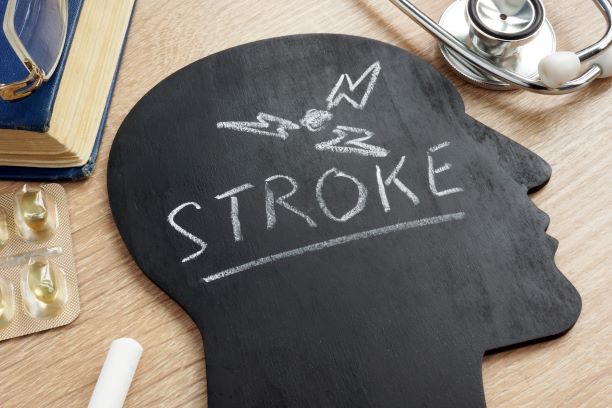
A stroke also known as a cerebrovascular accident (CVA) is an event where the blood supply to the brain becomes interrupted leading to a loss of oxygen. Lack of oxygen can lead to cellular death which can cause disabilities resulting in functional decline; and in more extreme cases, death.
A stroke is a medical emergency. Brain cells begin to die after just a few minutes of lack of blood supply and can cause irreversible damage if treatment and rehabilitation are delayed. This is why it is so important to get emergency help immediately after noticing the signs and symptoms of a stroke.
I know what you are probably wondering, what are the signs and symptoms of a stroke? In the next few paragraphs, I will be summarizing types of stroke, signs and symptoms of a stroke, characteristics of a stroke, and rehabilitation following a stroke. Hopefully, this will give you a better understanding of what to expect.
Types of Stroke
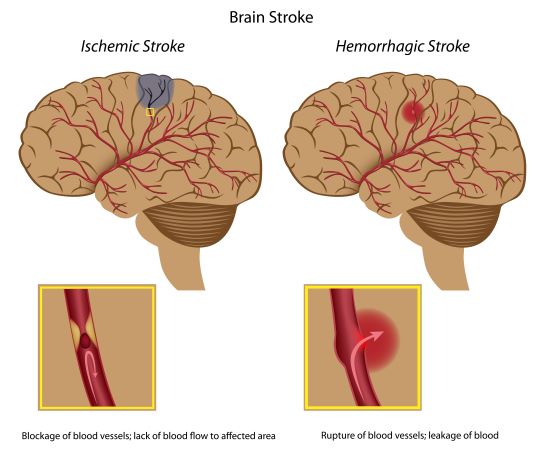
There are three main types of strokes which include: ischemic strokes, hemorrhagic strokes, and transient ischemic attacks (TIA).
Ischemic Strokes
Ischemic strokes are caused by an object, usually blood clots or plaque that disrupts blood supply to the brain. Furthermore, there are two types of ischemic strokes: thrombus and embolus.
A thrombus, which causes 80% of ischemic strokes, is when plaque or blood clots form in the blood vessels eventually causing a disruption in blood flow. 2
An embolus, which causes 20% of ischemic strokes, is when blood clots or plaque form in a different area of the body (ie: leg, heart), travel through the bloodstream, and occludes the blood vessels of the brain.
Embolic strokes occur rapidly, while thrombolytic strokes occur slowly over time. There are several conditions that can cause embolic strokes, which include, but are not limited to: 2
- Mitral Valve Disease
- Deep Vein Thrombosis (DVT)
- Atrial Fibrillation (A-Fib)
Hemorrhagic Strokes
Hemorrhagic strokes, which are responsible for 15%-20% of strokes, occur when blood vessels rupture leading to abnormal bleeding in the brain.2
Abnormal bleeding in the brain can build up causing compression of the brain tissue. Furthermore, the disruption of oxygen to the brain is caused by the loss of blood flow from the bleeding, and the compression of brain tissue.
Property of rehaballey.com
Hemorrhagic strokes can also occur rapidly and progress very quickly. If bleeding continues, evidence shows this type of stroke can be very fatal. 50% of deaths from hemorrhagic stroke occur within the first 48 hours. 2
Transient Ischemic Attack (TIA)
A transient ischemic attack or mini-stroke is usually associated with a thrombolytic stroke caused by atherosclerosis. 2 A TIA is caused by a temporary blockage in the artery.
The temporary disruption in blood flow causes symptoms similar to a stroke but resolves in a matter of a few minutes. This leads to very little brain tissue damage, and patients usually do not have any permanent disabilities.
TIAs, however, should still be taken seriously. A TIA can be a sign of impending stroke in the future.
Signs and Symptoms of a Stroke
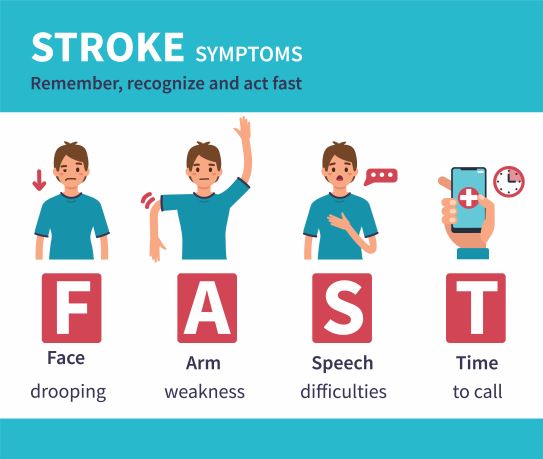
There are many different signs and symptoms of a stroke depending on where the stroke occurred. The most common signs and symptoms are: 2
- Weakness or paralysis on one side of the body
- Balance deficits, increased falls
- Difficulty grasping or holding onto objects
- Visual impairments or double vision
- Speech impairments
- Confusion and memory impairments
- Behavioral/mood changes
- Severe headache with unknown cause
- Dizziness/Vertigo
According to the American Stroke Association, a way to quickly learn and screen for signs and symptoms of stroke is by using the acronym F. A.S.T (Link)
- F: Facial droop (Look to see if one side of the face droops)
- A: Arm weakness (Check to see if one arm is weak or numb)
- S: Slurred Speech (Check for signs of slurred speech)
- T: Time to cal 9-1-1 (Time is of the essence, call 9-1-1 immediately if you notice symptoms)
Characteristics of a Stroke
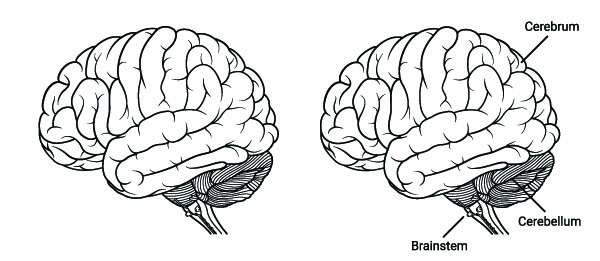
Several physical, behavioral, cognitive, and psychosocial impairments occur depending on the area of the brain that has been affected.
To keep things simple, I will not go into the specifics of each area of the brain. However, I would like to discuss some basic anatomy, so you can get a better understanding of how a stroke can affect your basic function.
Property of rehaballey.com
In simplest form, the brain can be divided into (4) main hemispheres.
- Right hemisphere
- Left hemisphere
- Brainstem
- Cerebellum
Right Hemisphere
I like to call the right side of the brain, the “sensory” brain because this is the part of the brain that interprets sensory input from the environment.
Simply put, it interprets body movements and how your body relates to the environment around you. It also picks up nonverbal cues from the environment such as facial expressions. The right side of the brain interprets input such as: 2
- Nonverbal processing and communications
- Body image
- Artistic abilities
- Hand-eye coordination
- Understanding music
- Spatial awareness
- Mathematical reasoning
- Negative emotions
- Controls left side body movements
Therefore, if an individual has a stroke on the right side of the brain, this individual may experience: 2
- Left side weakness
- Vision loss on the left
- Left side inattention or neglect
- Decreased awareness/judgment
- Decreased attention span
- Impulsive behavior (acting without thinking)
- Decreased spatial awareness (ie: depth perception)
- Emotional lability (ie: crying unexpectedly)
Left Hemisphere
I like to think of the left side of the brain as the “intellectual” brain because this side of the brain controls logical, rational thinking. The left side of the brain also controls mathematical calculations and interprets written and spoken language. The left side of the brain is responsible for: 2
- Written and spoken language
- Understanding language
- Analytics
- Logic
- Mathematical calculations
- Positive emotions (happiness)
- Rationality
- Controls right side body movements
Therefore, if an individual were to have a stroke on the left side of the brain, this person may experience: 2
- Aphasia (difficulty speaking/understanding language)
- Right side vision loss
- Right side body weakness
- Decreased ability to process information
- Difficulty with logic
- Difficulty with mathematics
Brainstem
I like to refer to the brainstem as the “vital” brain, because the brainstem is responsible for all of your vital functions such as regulation of blood pressure, breathing, swallowing, and heart rate. An individual with a stroke in the brainstem may experience complications such as: 2
- Unstable vitals signs
- Weakness on one or both sides of the body
- Decreased ability to swallow
- Decreased consciousness
- Difficulty with balance
- Dizziness/Vertigo
Cerebellum
Finally, I refer to the cerebellum part of the brain as the “equilibrium” brain. This is the part of the brain that is responsible for your balance and movement coordination. The cerebellum is responsible for interpreting: 2
- Muscle coordination
- Motor sequencing
- Muscle timing
- Balance
- Creativity
An individual that has a stroke in the cerebellum may experience:
- Decreased balance
- Ataxia (decreased coordination)
- Difficulty fine-tuning movements (smooth movements)
- Nystagmus (rapid eye movements)
**Alley Tips: It is important to note that this is just a very brief overview of the function of the brain. The brain is far more complex. Therefore individuals may experience different symptoms depending on the specific area of the brain that has been affected**
Risk Factors and Prevention

As with any other disease, strokes come with a host of risk factors. Some of these risk factors can be prevented (controllable risk factors), and some risk factors can not be prevented (non-controllable risk factors).
Although we can not change non-controllable risk factors that make up who we are, we can do our part to change controllable risk factors. Examples of non-controllable risk factors include:
- Age
- Gender
- Family history
- Race/Ethnicity
- Genetics
- Past medical history
Examples of controllable risk factors include: 2
- Obesity
- High blood pressure
- High cholesterol
- Diabetes
- Heart conditions
- Smoking
- Physical inactivity
- Use of certain medications
Prevention
In order to reduce your risk of having a stroke, it is important to refrain from smoking, reduce stress, get plenty of sleep, maintain a healthy diet, and exercise on a regular basis. I am not a nutritionist and can not give specific nutrition advice.
However, countless studies have shown that eating a healthy diet is the single most important way to reduce metabolic syndrome such as obesity, high blood pressure, and high blood sugar. Most experts would even argue that metabolic syndrome is solely caused by a poor, western-style diet.
Patient Example
Several of my patients have experienced improvements in their health just by changing the foods that they eat. That’s it!! Take my patient, Mr. J, for example. Mr. J (name changed to hide identity), was a patient of mine in the inpatient rehabilitation unit after experiencing a fall at home.
. J told me that before this incident, he was in the hospital previously due to multiple heart surgeries including stents and bypasses, as well as high blood pressure and diabetes.
Property of rehaballey.com
Mr. J finally had enough and decided to go on a plant-based diet, free from excess sugar and processed foods. He was proud to state that not only was his cholesterol lower, but his heart looked great, and he was completely cured of his diabetes, and high blood pressure. When I asked if he did anything else, he said: “Nope, I just changed my diet.”
Importance of Exercise
Maintaining an active lifestyle is also very important for both younger and older adults. Research has shown in older adults, regardless of the amount of time you spend exercising, increased sitting can increase disability.
Therefore it is important to stay active and engaged throughout the day. Now, staying active does not always mean rigorous gym activities, although going to the gym is helpful.
Simple activities around the house are enough activities for older adults. If you would like simple ways to stay active, you can refer to my blog by clicking HERE.
Rehabilitation After a Stroke
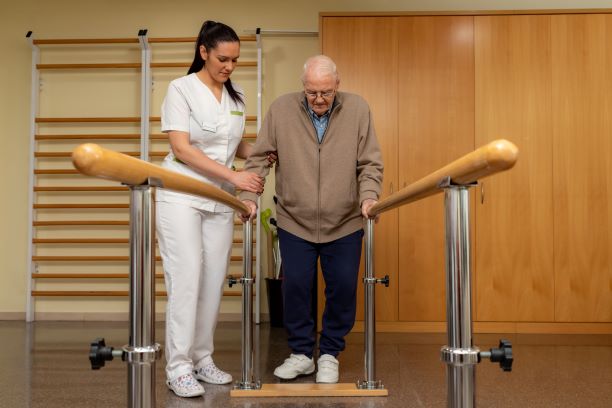
Engaging in rehabilitation post-stroke is crucial for your recovery, and here’s why. As mentioned above, a stroke disrupts the flow of oxygen to the brain, as a result brain cells begin to die. Brain cell death is largely believed to be irreversible, although some studies have attempted to prove otherwise.
The brain, however, does form new communication pathways through a process known as neuroplasticity. Through neuroplasticity, the brain will form new pathways to compensate for the damage. Simply put, the brain can relearn old functions, making recovery after stroke possible.
Property of rehaballey.com
Time is of the essence. Research has shown that recovery after a stroke is highest in the first three months following a stroke. This means that you have the highest chance of recovering from a stroke in the first three months.
After three months, recovery is still possible but slows significantly. From my experience as a therapist, I have seen very minimal recovery after a year post-stroke.
What Should I Expect in the Hospital?
Once you get admitted to the hospital, your doctor and/or healthcare team will run tests to properly diagnose your stroke. If you have had an ischemic stroke, anticoagulants or blood thinners may be administered to reduce the effects of the stroke.
One such drug known as a tPA (tissue plasminogen activator) is an FDA-approved drug that breaks down blood clots. This particular drug has been shown to greatly reduce the disabling effects of stroke by restoring oxygen to the brain.
Symptoms of stroke must be within a 4.5-hour window in order for patients to be eligible to receive this drug.
Once the doctor has stabilized you then he/she may request rehabilitation services.
What Should I Expect in Rehabilitation?
Inpatient rehabilitation is usually the most recommended after a stroke because of the high intensity of the therapy. Patients also have access to multiple healthcare disciplines to ensure they are receiving the maximum level-of-care.
In an Inpatient Rehabilitation Facility, patients will be receiving 3 hours of therapy each day, for 5-6 days/week. The 3 hours of therapy will consist of Physical Therapy, Occupational Therapy, and Speech Therapy (if needed).
Each discipline has different roles and will be working to rehabilitate the patient in different ways. For additional information on the specific roles of each therapist, you can refer to my blog by clicking HERE.
Property of rehaballey.com
During inpatient rehabilitation, therapists will be working to restore physical and cognitive functions. Patients will be engaging in activities designed to promote neuroplasticity and improve overall independence. The goal of inpatient rehabilitation is for the patient to return home functioning as independently as possible.
**Alley Tips: It is important to note that discharge from inpatient rehabilitation is not the end of therapy. Most often patients will progress to another level-of-care to continue rehabilitation, which can last up to a year depending on the severity**
Depending on the type and severity of the stroke, doctors may not recommend inpatient rehabilitation but may recommend a different therapy setting instead. Click HERE for more information on the different types of therapy settings, and what to expect with each.
Property of rehaballey.com
Hopefully, this article gives you more information on what to expect with strokes. Strokes can be prevented, and recovery is possible with the right information, interventions, and treatments.
Feel free to visit my website at https://rehaballey.com/ for more information on early rehabilitation and equipment recommendations. GOD BLESS YOUR ENDEAVORS!!
Resources
- Centers for Disease Control and Prevention: https://www.cdc.gov/stroke/facts.htm
- Giles SM. PTEXAM: the Complete Study Guide. Scarborough, Me: Scorebuilders; 2012.
- American Stroke Association: https://www.stroke.org/en/about-stroke/treatment/ischemic-stroke-treatment
